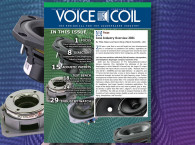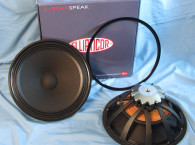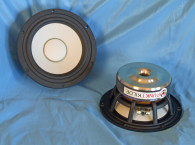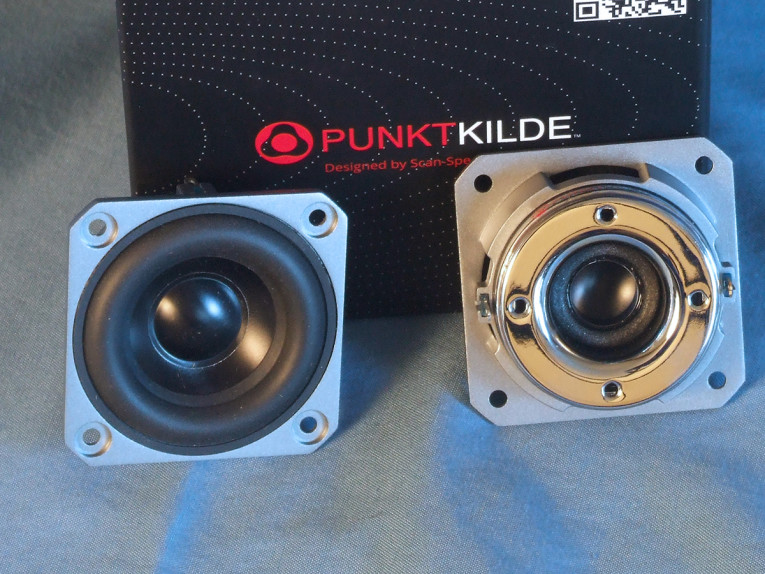
Eastech’s AUGWL0006-JN01 is built on a proprietary die-cast four-spoke aluminum frame. The cone assembly consists of a black anodized aluminum cone, with a 20mm diameter black anodized aluminum dust cap, and suspended with a NBR surround. Instead of using a spider assembly, this woofer has a 25mm round foam surround to supply the additional compliance and centering for the cone assembly (Photo 1). The inside diameter of the foam surround is attached with an aluminum collar to the underside of the dust cap, so fairly clever.
This driver has a rather unusual motor structure comprised of a large (for a 2.25” woofer) 35.55mm diameter under hung voice coil that rides inside a double set of neodymium ring magnets. A chrome-plated return cup has four 3mm diameter vents for additional cooling. Tinsel leads connect on opposite sides the cone to a pair of solderable terminals.
I commenced testing the Eastech micro woofer using the LinearX LMS analyzer and the Physical Lab IMP Box to create both voltage and admittance (current) curves, with the driver clamped to a rigid test fixture in free-air at 0.3V, 1V, 3V, and 6V. It should also be noted that this multi-voltage parameter test procedure includes heating the voice coil between sweeps for progressively longer periods to simulate operating temperatures at that voltage level (raising the temperature to the first and second time constants).
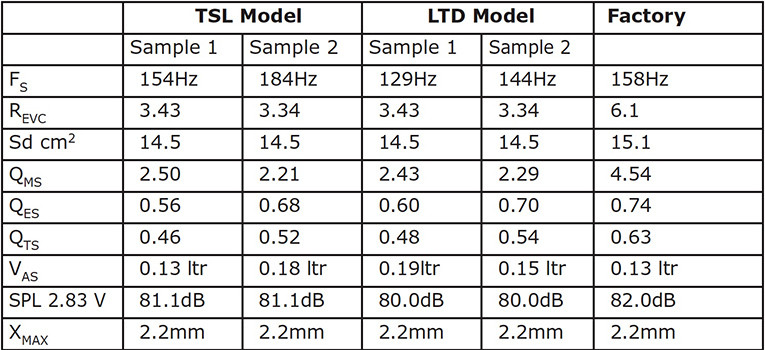



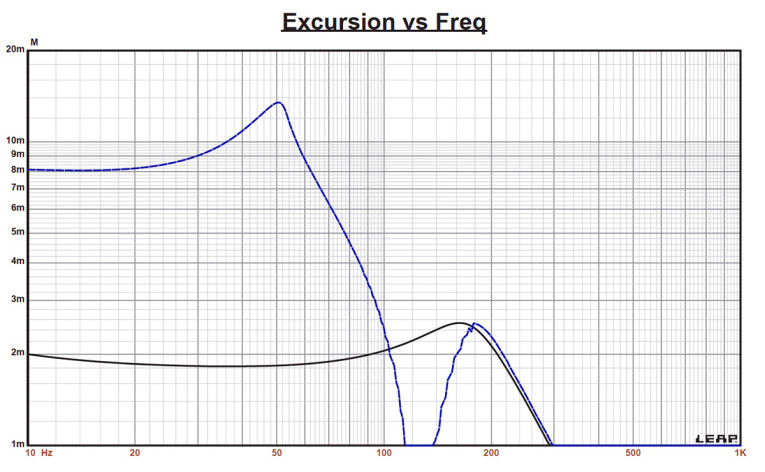
Next, I post-processed the six 550-point stepped sine wave sweeps for each of the AUGWL0006-JN01 samples and divided the voltage curves by the current curves (admittance) to produce the impedance curves, the phase generated by the LMS calculation method. I imported the data, along with the accompanying voltage curves, into the LEAP 5 Enclosure Shop software. I selected the complete data set, the multiple voltage impedance curves for the LTD model, and the 1V impedance curve for the TSL model in the transducer derivation menu in LEAP 5 and created the parameters for the computer box simulations. Figure 1 shows the 1V free-air impedance curve. Table 1 compares the LEAP 5 LTD and TSL data and factory parameters for both of the AUGWL0006-JN 01 samples.
LEAP TSL parameter calculation results for the AUGWL0006-JN 01 were reasonably close to the factory data, but I also did a simulation with the factory data and confirmed that the factory data produced an F3 within 3Hz of my data. As always, I followed my usual protocol and set up the computer enclosure simulations using the LEAP LTD parameters for Sample 1. This consisted of a Butterworth sealed box with 50% fiberglass damping material with a volume of 8 in3, and a 14.1 in3 Chebychev/Butterworth vented alignment tuned to 74Hz with 15% damping material in the box.
Note that I use the simulated fiberglass (R19) selection in LEAP 5 primarily because it is accurate and a known commodity in terms of damping. However, due to its carcinogenic nature, fiberglass is almost never used anymore. Most damping material used today is either foam or some form of Dacron batting. While LEAP 5 does model polyester, the density is not as well established as fiberglass.
Figure 2 displays the results for the woofer in the sealed and vented box simulations at 2.83V and at a voltage level sufficiently high enough to increase cone excursion to Xmax + 15% (2.5mm for the AUGWL0006-JN01). This produced a F3 frequency of 202Hz (F6 = 157Hz) for the 8 in3 sealed enclosure and –3dB = 114Hz (-6dB = 104Hz) for the 14.1 in3 damped Chebychev/Butterworth vented simulation.
Increasing the voltage input to the simulations until the maximum linear cone excursion was reached resulted in 93.8dB at 12.1V for the sealed enclosure simulation and 97.5dB at the same 12.1V input level for the vented enclosure. Figure 3 shows the 2.83V group delay curves. Figure 4 shows the 12.1V excursion curves.
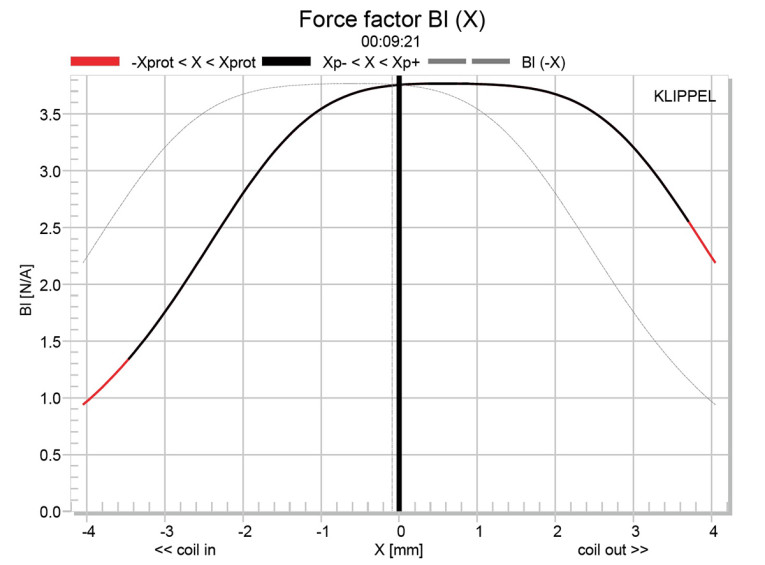
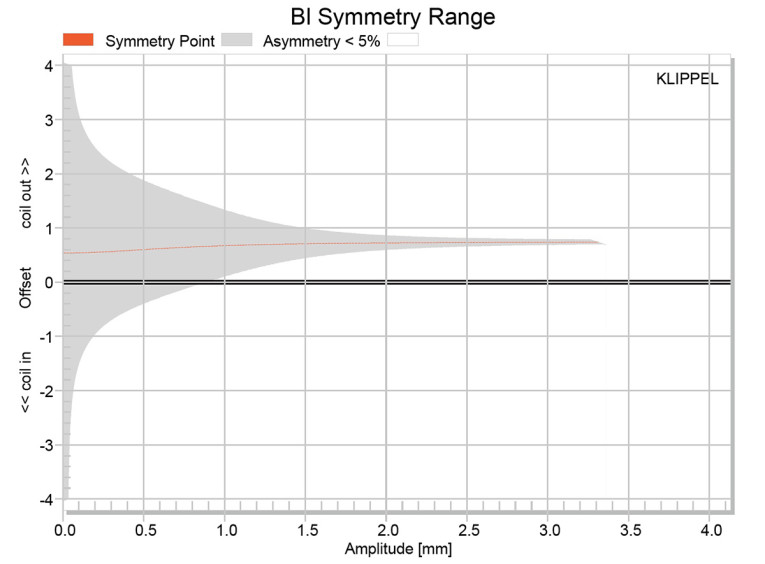
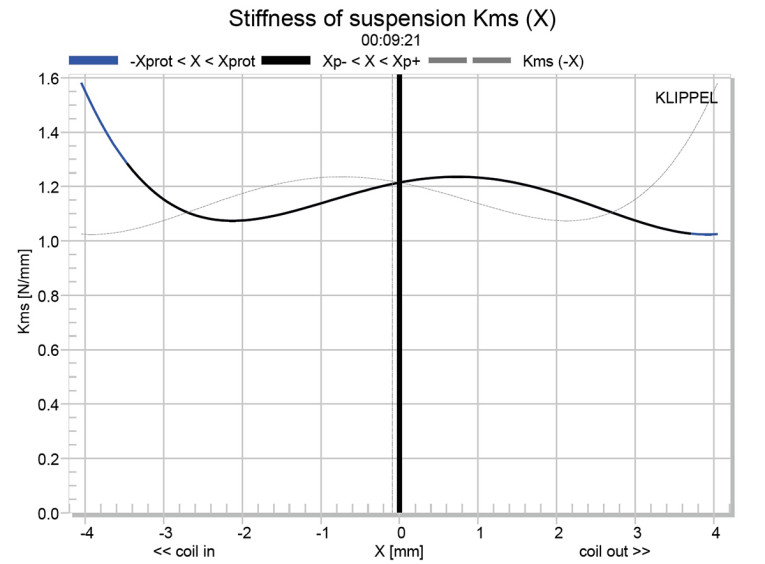
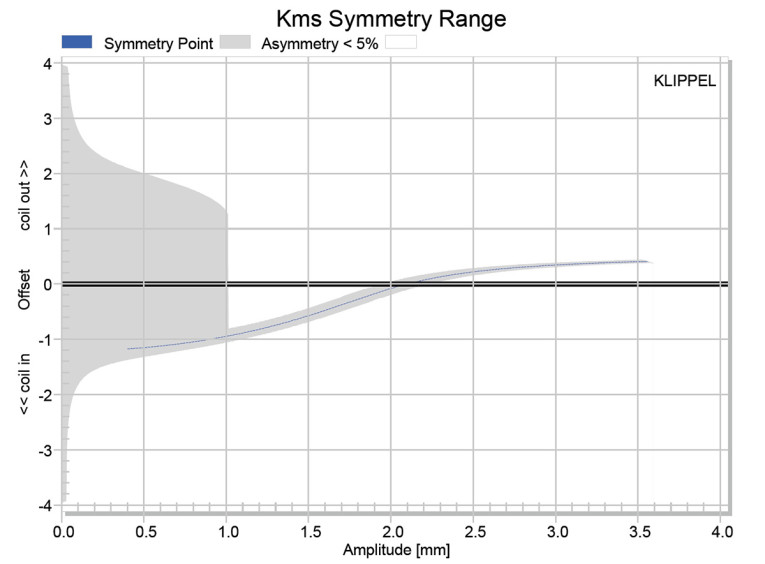
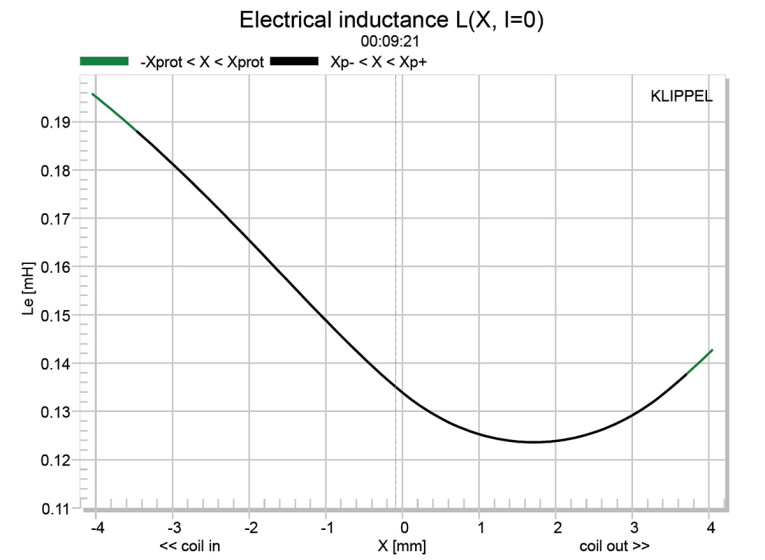
Klippel analysis for AUGWL0006-JN01 woofer produced the Bl(X), Kms(X), and Bl and Kms symmetry range plots given in Figures 5-8. The Bl(X) curve for the AUGWL0006-JN01 (Figure 5) is typical for a short Xmax driver and has an obvious degree of coil-out forward offset. Looking at the Bl Symmetry plot (Figure 6), this curve shows about 0.75mm of coil-out (forward) offset position of reasonable certainty (about 1.6mm) that remains mostly constant out to somewhat beyond the driver’s physical 2.2mm Xmax.
Figure 7 and Figure 8 show the Kms(X) and Kms symmetry range curves for the AUGWL0006-JN01 driver. The Kms(X) curve is not particularly symmetrical and does not resolve in the coil-out direction. Looking at the Kms symmetry range curve shown in Figure 8, the offset transitions from a coil-in offset to a coil-out offset at the physical Xmax. Displacement limiting numbers calculated by the Klippel analyzer for AUGWL0006-JN01 were XBl @ 70% Bl is 2.1mm and for XC @ 50% Cms was greater than 3.5mm, which means that for this Eastech woofer, Bl is the most limiting factor for prescribed distortion level of 20%, although it was close to the physical Xmax of the driver.
Figure 9 gives the inductance curve Le(X) for the AUGWL0006-JN01. Inductance will typically increase in the rear direction from the zero rest position as the voice coil covers more pole area, which is similar to what is happening to this driver, but in the coil-out direction it reaches a minimum and then increases somewhat. However, the inductance variation is only 0.04mH to 0.01mH from the coil-in and coil-out Xmax positions, which is good inductive performance.
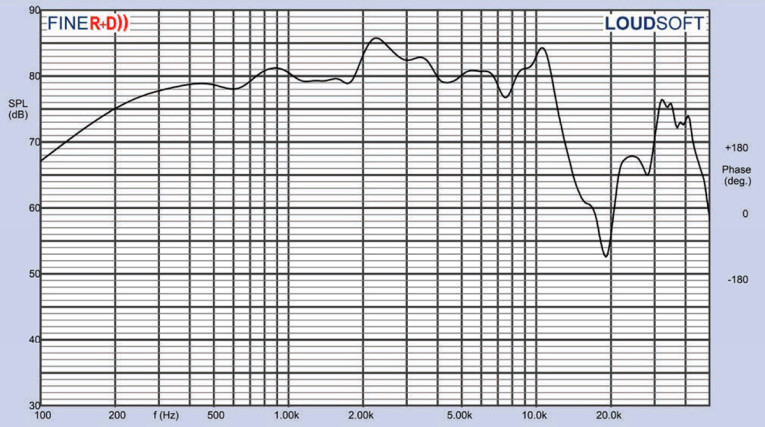
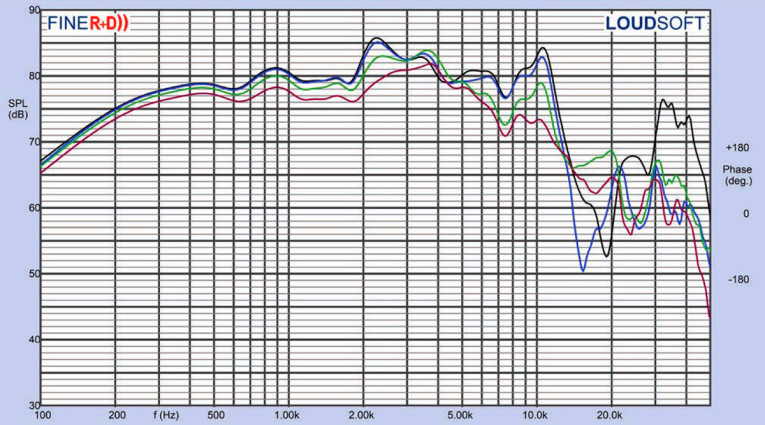
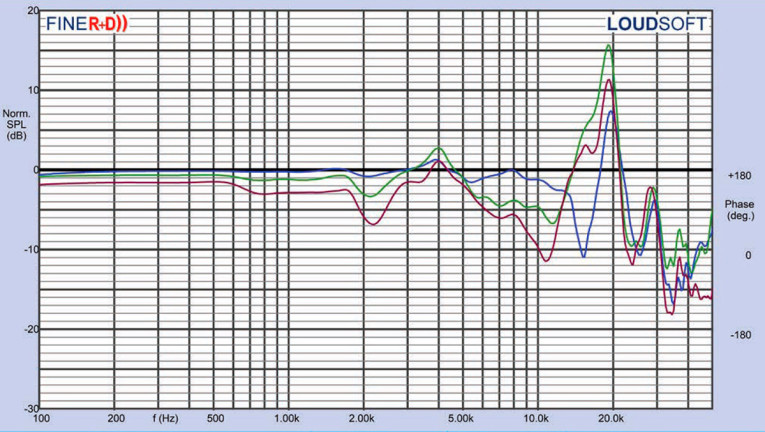


Next, I mounted the AUGWL0006-JN01 woofer in an enclosure, which had a 9” × 4” baffle and was filled with damping material (foam). I measured the transducer on- and off-axis from 300Hz to 40kHz frequency response using the LoudSoft FINE R+D analyzer (courtesy of LoudSoft) and the GRAS 46BE microphone (courtesy of GRAS Sound & Vibration) both on- and off-axis from 2.0V/0.5m normalized to 2.83V/1m, using the cosine windowed FFT method.
Figure 10 gives the AUGWL0006-JN01’s on-axis response indicating a ±4.5dB profile from about 250Hz to 12.5 kHz, with an aluminum breakup mode at 31kHz. There is a 6dB midband peak between 2kHz to 4 kHz with the drive having a steep roll-off between 12.5kHz and 20kHz. Equalizing this to the level below 1kHz would give a more balanced spectral profile, but at the expense at overall loudness, although it would likely make the vocal range more forward.
Figure 11 displays the on- and off-axis frequency response at 0°, 15°, 30° and 45°. Figure 12 gives the off-axis curves normalized to the on-axis response. Figure 13 shows the CLIO 180° polar plot (measured in 10° increments). Figure 14 shows the two-sample SPL comparison, indicating the two samples were closely matched within less than 1dB from 800Hz to 8kHz, with up to 2dB variations above and below those frequencies.

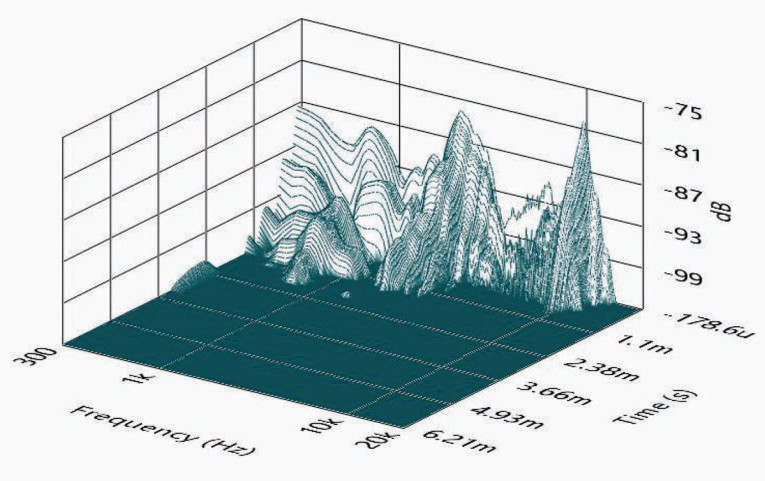
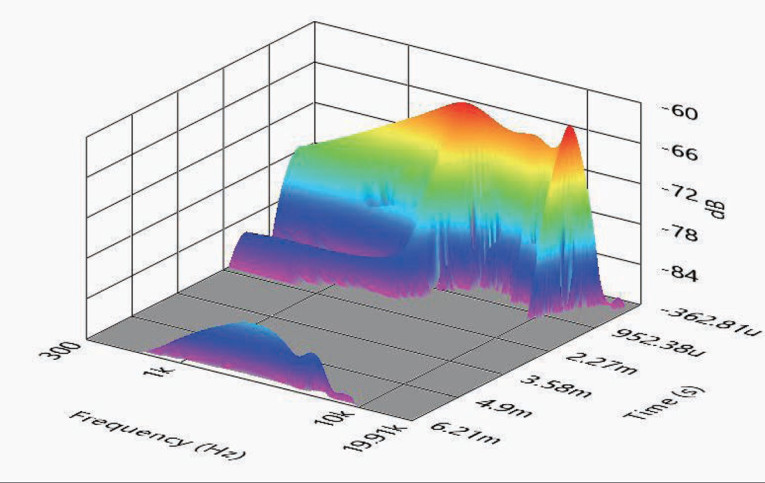
For the remaining series of tests, I employed the Listen AudioConnect analyzer operating with SoundCheck 18 along with the Listen 1/4” SCM microphone and power supply (courtesy of Listen, Inc.) to measure distortion and generate time-frequency plots.
For the distortion measurement, I mounted the AUGWL0006-JN01 woofer rigidly in free-air, and set the SPL to 90dB at 1m (8.15V) using a noise stimulus. Then, I measured the distortion with the microphone placed 10cm from the dust cap. This produced the distortion curves shown in Figure 15.
I then used SoundCheck to get a 2.83V/1m impulse response for this driver and imported the data into Listen’s SoundMap Time/Frequency software. Figure 16 shows the resulting cumulative spectral decay (CSD) waterfall plot. Figure 17 shows the Wigner-Ville plot (chosen for its better low-frequency performance).
While the intended application for this Eastech AUGWL0006-JN01 2.25” is as a woofer, suggesting a tweeter is required for full-range performance, its response out to 12kHz indicates that it could easily also be used for full-range applications. For more information about the AUGWL0006-JN01 and the other 46 drivers in the Eastech Punktkilde line, visit www.eastech.com. VC
This article was originally published in Voice Coil, February 2021.




